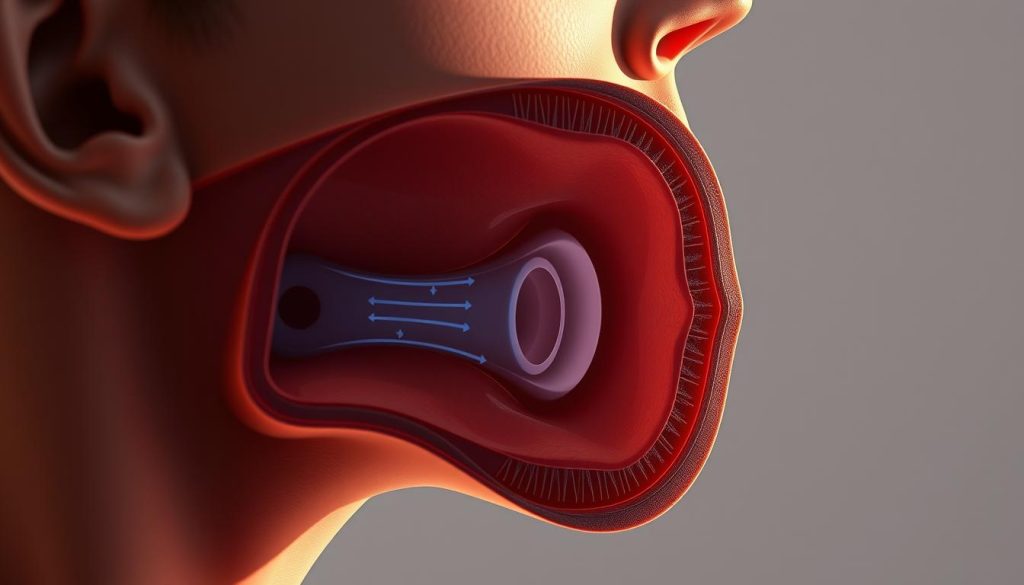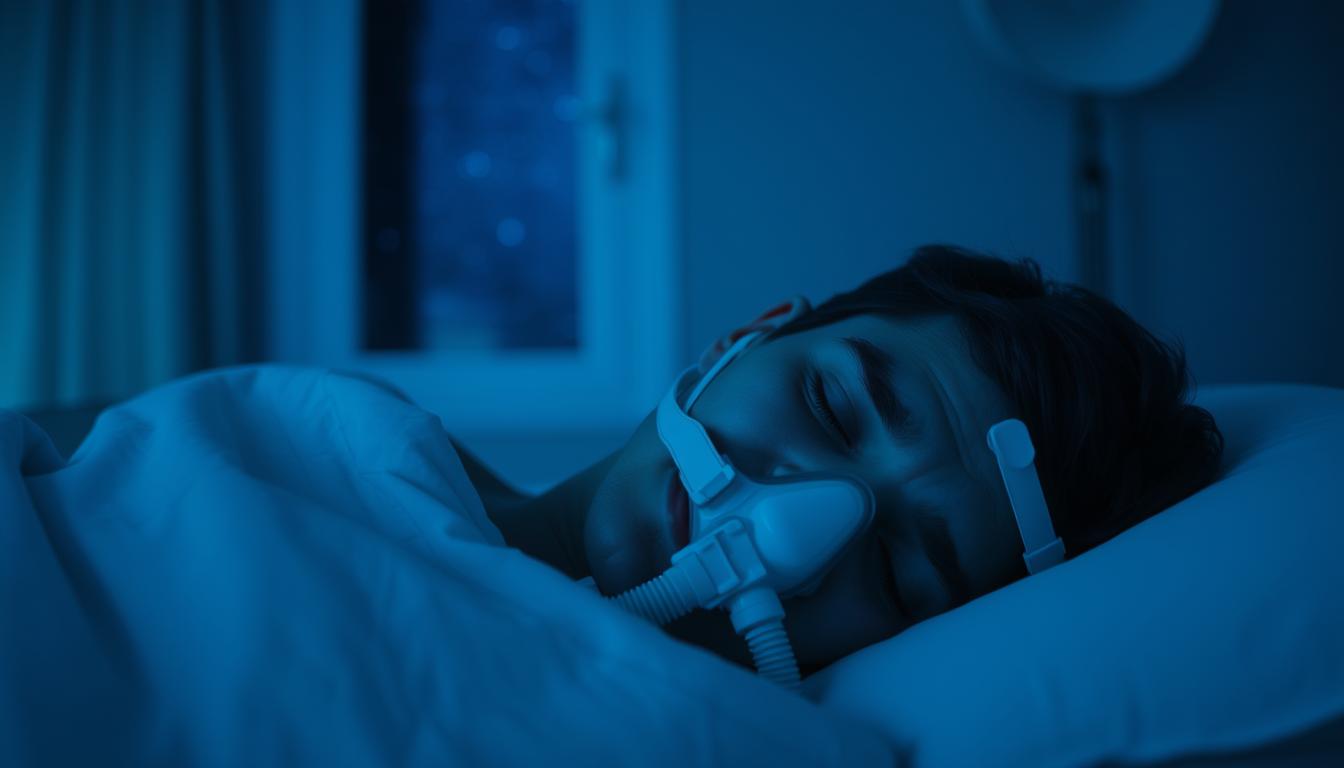Sleep apnea is a common condition where breathing repeatedly stops and starts during rest. This disorder can disrupt sleep quality and lead to serious health issues if left untreated. It’s essential to recognize the signs early to seek proper care.
There are two main types: obstructive and central. Obstructive sleep apnea occurs when the throat muscles relax, blocking the airway. Central sleep apnea happens when the brain fails to send the right signals to control breathing.
Common symptoms include loud snoring, gasping for air, and feeling tired during the day. These signs can affect daily performance and overall wellness. Understanding the condition is the first step toward finding effective treatment.
What Is Sleep Apnea?
Breathing disruptions during rest can signal a deeper health issue. This condition, known as sleep apnea, involves repeated pauses in breathing that can last from a few seconds to minutes. These interruptions can occur dozens of times each night, impacting overall health and well-being.
Defining Sleep Apnea for Better Sleep
Sleep apnea is categorized into two main types: obstructive and central. Obstructive sleep apnea happens when the throat muscles relax, blocking the airway. Central sleep apnea occurs when the brain fails to send proper signals to the muscles that control breathing.
In obstructive sleep apnea, the airway becomes partially or completely blocked during rest. This leads to reduced oxygen levels and frequent awakenings. Central sleep apnea, on the other hand, is less common and involves a miscommunication between the brain and breathing muscles.
Obstructive vs. Central Sleep Apnea
Obstructive sleep apnea is often linked to physical factors like excess weight or a narrow airway. Central sleep apnea is more related to underlying health conditions such as heart failure or stroke. Both types can significantly disrupt sleep quality and lead to daytime fatigue.
Risk factors for obstructive sleep apnea include obesity, smoking, and family history. For central sleep apnea, conditions like chronic pain or certain medications can increase the risk. Identifying these factors early can help in managing the condition effectively.
Accurate diagnosis is crucial for proper treatment. If left untreated, sleep apnea can lead to serious health complications like high blood pressure, heart disease, and diabetes. Recognizing the signs and seeking medical advice is the first step toward better sleep and improved health.
Understanding Sleep Apnea: In-Depth Look at Types and Symptoms
Many people experience breathing interruptions at night without realizing the underlying issue. These pauses can lead to a range of symptoms that affect both physical and mental health. Recognizing these signs early is crucial for effective management.

Common Symptoms and Signs
Excessive daytime sleepiness is one of the most noticeable symptoms. It can make it hard to stay awake during daily activities. Morning headaches are another common sign, often caused by fluctuations in blood oxygen levels.
Other symptoms include loud snoring, gasping for air, and waking up frequently at night. These disruptions can lead to poor sleep quality, leaving you feeling tired and irritable. If left untreated, these issues can worsen over time.
How Sleep Disruptions Affect Daily Life
Irregular pressure changes during sleep can strain the heart and increase blood pressure. This puts extra stress on the cardiovascular system, raising the risk of heart disease. Over time, these factors can lead to more serious health problems.
Lifestyle choices, such as alcohol consumption, can exacerbate symptoms. Alcohol relaxes the throat muscles, making it harder to breathe at night. Reducing or avoiding alcohol can help improve sleep quality.
Sleep disruptions also impact mental health, leading to mood swings, anxiety, and difficulty concentrating. Addressing these issues early can improve overall well-being and prevent long-term complications.
Research shows that recognizing symptoms early and seeking medical advice can make a significant difference. Proper diagnosis and treatment can restore restful sleep and improve quality of life.
Recognizing the Warning Signs and Health Risks
Persistent breathing issues at night can lead to serious health risks if ignored. These disruptions often stem from throat obstructions, causing cumbersome breathing patterns. Recognizing the early signs is essential to prevent long-term complications.
Daytime Fatigue and Cognitive Impacts
One of the most noticeable warning signs is excessive daytime fatigue. Poor sleep quality can leave you feeling drained and unable to focus. Cognitive effects, such as impaired concentration and mood disturbances, are also common.
Sleep studies and tests play a vital role in confirming the diagnosis. These evaluations help identify the root cause of breathing disruptions. Early detection can lead to effective treatment, improving overall health.
Cardiovascular and Metabolic Concerns
Untreated breathing issues can strain the cardiovascular system. This often leads to high blood pressure and an increased risk of heart disease. Historical data reinforces the link between these conditions and declining health.
Positive airway pressure devices are one of the primary treatments. They help maintain open airways, ensuring better breathing during rest. Lifestyle changes, such as weight management, can also reduce symptoms.
Addressing these warning signs early can prevent severe complications. Regular check-ups and awareness of family history are crucial steps. Taking action now can lead to a healthier, more restful future.
Exploring Causes and Risk Factors Behind Breathing Disruptions
Breathing disruptions during the night can stem from various factors, both genetic and environmental. These interruptions often result from a combination of physical traits and lifestyle choices. Identifying these causes is essential for effective management and treatment.

Genetic and Anatomical Considerations
Certain physical traits can make the airway more vulnerable to blockages. A narrow throat, enlarged tonsils, or a recessed jaw are common anatomical factors. These features can increase the likelihood of airway pressure changes during rest.
Family history also plays a role. If close relatives have experienced similar issues, the risk may be higher. Genetic predispositions can affect muscle tone in the throat, making it easier for the airway to collapse at night.
Lifestyle and Environmental Influences
Daily habits and environmental factors can significantly impact breathing during rest. Excess body weight, for example, can put pressure on the airway, leading to interruptions. Smoking and alcohol use can also relax throat muscles, worsening the problem.
Sleeping position is another key factor. Lying on your back can cause the tongue to block the airway. Making simple adjustments, like sleeping on your side, can help reduce these events.
| Risk Factor | Impact |
|---|---|
| Narrow Airway | Increases airway pressure changes |
| Excess Weight | Puts pressure on the airway |
| Smoking | Relaxes throat muscles |
| Sleeping Position | Can block the airway |
Monitoring oxygen levels during rest can provide insights into the severity of these events. Positive airway pressure devices are often used to maintain open airways and improve breathing. Addressing these risk factors early can lead to better sleep and overall health.
Diagnosing Sleep Apnea with Modern Techniques
Modern technology has revolutionized the way we detect and manage nighttime breathing issues. Accurate diagnosis is essential for effective treatment, and today’s methods offer both precision and convenience. Two primary approaches are widely used: in-lab polysomnography and at-home sleep studies.
In-Lab Polysomnography
In-lab polysomnography is a comprehensive test conducted at a specialized sleep center. During this study, multiple sensors monitor your breathing, heart rate, brain activity, and oxygen levels. This detailed data helps healthcare professionals identify the severity of breathing disruptions.
Spending the night at a sleep center ensures accurate results under controlled conditions. The process is non-invasive and provides a complete picture of your sleep patterns. This method is particularly useful for complex cases or when other tests are inconclusive.
At-Home Sleep Studies
At-home sleep studies offer a convenient alternative for diagnosing breathing issues. Portable devices are used to measure key indicators like airflow, oxygen levels, and breathing patterns. These FDA-approved tools are easy to use and provide reliable data in the comfort of your own home.
While at-home tests are less comprehensive than in-lab studies, they are ideal for initial screenings. They also reduce the need for overnight stays at a sleep center. However, they may not capture all nuances, especially in complex cases.
| Diagnostic Method | Advantages | Limitations |
|---|---|---|
| In-Lab Polysomnography | Comprehensive data, controlled environment | Requires overnight stay, higher cost |
| At-Home Sleep Studies | Convenient, cost-effective | Less detailed, may miss complex issues |
Both methods play a crucial role in diagnosing breathing disruptions. The choice depends on individual needs and the complexity of the condition. Early detection and accurate diagnosis are key to effective treatment and improved quality of life.
Navigating Treatment Options and Lifestyle Modifications
Effective management of nighttime breathing issues often requires a combination of treatments and lifestyle changes. Addressing these disruptions can significantly improve quality of life and reduce daytime sleepiness. Let’s explore the primary options available.

Positive Airway Pressure (PAP) Therapy
PAP therapy is one of the most common treatments for managing breathing disruptions. It uses a device to deliver continuous positive airway pressure, keeping the airway open during rest. This reduces apnea episodes and improves oxygen levels.
CPAP machines are a popular type of PAP therapy. Studies show they effectively reduce daytime sleepiness and improve overall sleep quality. Many users report feeling more alert and energetic after consistent use.
Oral Appliances and Surgical Interventions
Oral appliances are another option for those who find CPAP machines uncomfortable. These devices reposition the jaw and tongue to keep the airway open. They are particularly useful for mild to moderate cases.
In advanced cases, surgical interventions may be necessary. Procedures like uvulopalatopharyngoplasty (UPPP) or jaw repositioning can help alleviate symptoms. A sleep study is often required to determine the best course of action.
| Treatment | Benefits | Considerations |
|---|---|---|
| CPAP | Reduces apnea episodes, improves oxygen levels | May take time to adjust to the device |
| Oral Appliances | Comfortable, non-invasive | Best for mild to moderate cases |
| Surgery | Effective for severe cases | Requires recovery time |
Lifestyle changes can also play a significant role in managing symptoms. Weight loss, positional therapy, and avoiding alcohol can complement medical treatments. Combining these approaches often leads to the best results.
Research continues to highlight the effectiveness of these treatments. By addressing the causes of sleep apnea early, you can enjoy better rest and improved health.
Advances in Therapy and Medical Innovations
Recent advancements in medical science are transforming how we approach nighttime breathing issues. New medications, devices, and research are offering hope for better management and improved quality of life. These innovations are reshaping treatment protocols and providing personalized solutions.
Breakthrough Medications and FDA Approvals
One of the most exciting developments is the FDA approval of drugs like Zepbound. These medications target moderate to severe cases, helping to reduce symptoms and improve sleep quality. They work by addressing the underlying causes, such as airway blockages and brain signaling issues.
Research shows that these drugs can significantly reduce daytime fatigue and improve overall health. They are particularly effective for individuals with a family history of similar conditions. Early results from clinical trials are promising, paving the way for broader use.
Emerging Devices and Future Research
Innovative devices are also making waves in the treatment landscape. New technologies focus on improving air flow and reducing apnea events. These devices are designed to be more comfortable and user-friendly, encouraging consistent use.
For example, advanced CPAP machines now come with features like auto-adjusting pressure and quieter operation. Oral appliances have also evolved, offering better fit and effectiveness. These advancements are helping patients achieve better results with less discomfort.
Future research is exploring the brain’s role in controlling airway function during rest. Studies are also investigating how weight management and genetic factors influence treatment outcomes. This personalized approach is expected to revolutionize care in the coming years.
| Device | Features | Benefits |
|---|---|---|
| Auto-Adjusting CPAP | Dynamic pressure changes, quiet operation | Improved comfort, better air flow |
| Next-Gen Oral Appliances | Custom fit, lightweight design | Reduced apnea events, easy to use |
| Wearable Monitors | Real-time data tracking, mobile app integration | Enhanced monitoring, personalized insights |
These innovations are not just improving treatment options but also enhancing our understanding of the condition. As research continues, we can expect even more effective solutions to emerge. Staying informed about these advancements is key to managing symptoms and improving overall health.
Final Thoughts on a Restful Night’s Journey
Recognizing the signs of nighttime breathing issues can lead to better health outcomes. Early detection of symptom sleep patterns is crucial for effective management. Addressing these disruptions can have a profound effect on daily energy and focus.
Thorough treatment not only improves rest but also enhances overall quality of life. Consulting a healthcare professional is the first step toward finding the right solution. With advancements in medical technology, the future of managing these issues looks promising.
By taking action now, you can enjoy a healthier, more restful future. Stay informed and proactive to ensure the best possible outcomes for your well-being.

